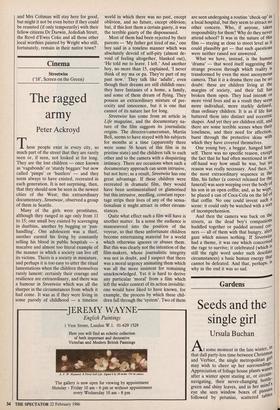Cinema
Streetwise (`18', Screen on the Green)
The ragged army
Peter Ackroyd
These people exist in every city, so much part of the street that they are rarely seen or, if seen, not looked at for long. They are the lost children — once known as 'vagabonds' or 'sturdy beggars' but now called 'pimps' or 'hustlers' — and they seem always to have existed, recreated in each generation. It is not surprising, then, that they should now be seen in the newest cities of the West; this extraordinary documentary, Streetwise, observed a group of them in Seattle.
Many of the girls were prostitutes, although they ranged in age only from 11 to 15; one small boy existed by scavenging in dustbins, another by begging or 'pan- handling'. One adolescent was a thief, another earned his living by constantly selling his blood in public hospitals — a macabre and almost too literal example of the manner in which a society can live off its victims. Theirs is a society in miniature, and perhaps it is too easy to utter the ritual lamentations when the children themselves rarely lament: certainly their courage and resilience are extraordinary, and there was a humour in Streetwise which was all the sharper in the circumstances from which it had come. It was as if they were living in some parody of childhood — a timeless world in which there was no past, except oblivion, and no future, except oblivion; but, if this lent them a certain gaiety, it was the terrible gaiety of the dispossessed.
Most of them had been rejected by their parents — 'My father got tired of me,' one boy said in a toneless manner which was absolutely devoid of self-pity (almost de- void of feeling altogether, blanked out), `He told me to leave. I left.' And another boy, no more than 15, explained, 'I never think of my ma or pa. They're part of my past now.' They talk like 'adults', even though their dreams are still childish ones: they have fantasies of a home, a family, and some of them dream of flying. They possess an extraordinary mixture of pre- cocity and innocence, but it is one that cannot of its nature last for long.
Streetwise has come from an article in Life magazine, and the documentary na- ture of the film suggests its journalistic origins. The director/cameraman, Martin Bell, seems to have stayed with his subjects for months at a time (apparently there were some 56 hours of this film in its pristine state) and the children talk to each other and to the camera with a disquieting intimacy. There are occasions when such a documentary approach can seem intrusive, but not here; as a result, Streetwise has one great advantage. If these children were recreated in dramatic film, they would have been sentimentalised or glamorised but this intrusive, needling, constant repor- tage strips their lives of any of the sensa- tionalism it might attract in other circum- stances.
Quite what effect such a film will have is another matter. In a sense the audience is manoeuvred into the position of the voyeur, so that these unfortunate children become entertaining material for a world which otherwise ignores or abuses them. But this was clearly not the intention of the film-makers, whose journalistic integrity was not in doubt, and I suspect that there was a moral urgency animating them which was all the more insistent for remaining unacknowledged. Yet it is hard to derive any particular 'moral' from a film which left the wider context of its action invisible: one would have liked to have known, for example, the process by which these chil- dren fall through the 'system'. Two of them are seen undergoing a routine 'check-up' in a local hospital, but they seem to attract no other concern. Who, if anyone, takes responsibility for them? Why do they never attend school? It was in the nature of this film — staying as close to street level as it could plausibly get — that such questions were neither raised nor answered.
What we have, instead, is the human `drama' — that word itself suggesting the strange process through which reality is transformed by even the most anonymous camera. That it is a drama there can be no doubt: these are children living at the margins of society, and their fall has broken them open. They lead intenst or more vivid lives and as a result they seem more individual, more starkly defined, than ordinary children. It is as if life has battered them into distinct and eccentric shapes. And yet they are children still, and there are some terrible scenes when their loneliness, and their need for affection, burst through the protective skins with which they have covered themselves.
One young boy, a beggar, hanged him- self. There was no specific reason, except the fact that he had often mentioned in an off-hand way how small he was, but 110 reason was really necessary. And then, in the most extraordinary sequence in the film, his father (a convict released for the funeral) was seen weeping over the body of his son in an open coffin; and, as he wept, he placed a can of Coca-Cola on the lid of that coffin. No one could invent such a scene: it could only be watched with a sort of incomprehension. And then the camera was back on the streets, as the dead boy's companions huddled together or padded around cor- ners — all of them with that hungry, alert gaze which misses nothing. If Streetwise had a theme, it was one which concerned the rage to survive; it celebrated (which Is still the right word under such desolate circumstances) a basic human energy that cannot be defeated. And that, perhaps, is why in the end it was so sad.














































 Previous page
Previous page